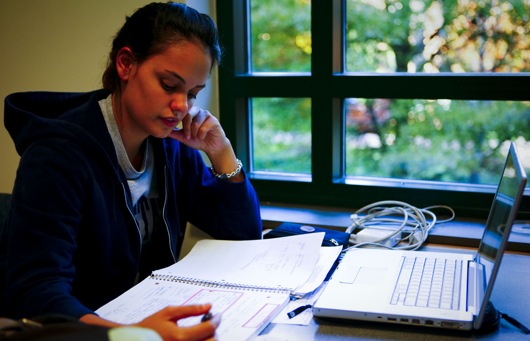Five-year plan to bolster student scholarship, create research opportunities

GMU junior Natalie Jones studies in the Johnson Center. Next March the Southern Association of Colleges and Schools will evaulate GMU for reaccrediation. (Daniel McEnrue)
With the Southern Association of Colleges and Schools set to visit George Mason University in March as part of the reaccreditation process, work continues on the Quality Enhancement Plan that is part of SACS’ requirements.
In order to receive reaccreditation, SACS requires schools to come up with a five-year plan to improve an issue related to student learning at the institution.
After a lengthy selection process that involved students, faculty and staff, it was decided that Mason would institute a plan that will begin fall 2011.
It is designed to improve undergraduate scholarship and research opportunities, said Kim Eby, associate provost for faculty development and the director of the Center for Teaching Excellence at Mason.
“We had to show that the topic for our plan is based on institutional data,” Eby said. “If you look at the kinds of information we collected, there is a strong indication that this is addressing concerns on campus.”
The QEP has three primary tenets: increasing opportunities for students to get involved in scholarship and practice scholarly inquiry, creating more opportunities for students to engage with faculty outside of the classroom and establishing an infrastructure that helps to enable student scholarship, Eby said.
“We are going to encourage more classes to be inquiry based,” said Bethany Usher, associate director of the Center for Teaching Excellence. “We want students to be involved in the process of scholarly inquiry within their curriculum.”
Usher said the plan involves an expansion of the undergraduate apprenticeship program, which enables students to conduct mentored research with faculty and graduate students.
The QEP will focus on creating more opportunities for student-faculty interaction outside the classroom.
“One of the things we know from assessment data is that, compared with our peer institutions, Mason students report not having as much one-on-one interaction with faculty outside the classroom,” Eby said.
Eby said research shows a strong correlation between student success and engagement with faculty outside the classroom.
The QEP will create an infrastructure through the addition of an Office of Student Scholarship, Creative Activities and Research.
“OSCAR is going to be an office where we are going to coordinate activities for students so the undergraduate apprenticeship program will move into that office,” Usher said.
Usher said the office will feature a list of classes that include inquiry-based learning.
The office will coordinate what will be known as the OSCAR Fellows, a group that will make appearances in Mason classes to discuss their experiences with scholarly inquiry and inform students on how to get involved.
Another part of the new infrastructure will be a database, structured in the same way as HireMason, which will allow faculty to post requests for student help in research projects.
Funding for these additions comes from funds that are, for the most part, allocated out of the provost’s budget.
“The majority of the money goes to student learning through the inquiry based courses and undergraduate apprenticeship,” Usher said. “The majority of it isn’t going toward furniture or anything like that, but toward implementing things that positively impact student learning.”
“One of the things we have seen is that when we have met with students, they had a hard time finding opportunities that fit into their busy schedules,” Usher said. “This way they can find things they will be interested in.”
Another part of the QEP calls for one-credit classes that give students a chance to conduct scholarly research and inquiry, Eby said.
“Let’s say I’m a professor in journalism and I’m teaching a course that focuses on social media. I’d be able to offer a smaller group of my students the opportunity to take a one-credit add-on that would research trends within social media,” Eby said.
The QEP also includes provisions for a fund that would help finance student travel, Eby said.
“One of the things we’ve heard in our focus groups and from our faculty members is that they wish there was more support for students engaged in this kind of work,” Eby said. “We’ll offer modest financial support so that students can travel and present their research work at conferences.”
Eby said some students may engage in projects outside their major.
“We’ll involve interdisciplinary research,” Eby said. “We would like to see more scholarly engagement within interdisciplinary areas.”
The QEP Topic Selection Committee was formed in April 2008 by University President Alan Merten and Provost Peter Stearns.
Eby said the topic of student scholarship was one of 12 finalists that were made public. The selection committee identified potential topics and then students and faculty were invited to contribute their suggestions.
“We received eight suggestions from the university community,” Usher said. “Most of the students who submitted proposals joined with a faculty team. Almost all of the ideas had student input.”
Eby said one criterion in the selection process was that all levels of the university – including alumni – supported the plan.
The committee narrowed the 12 suggestions down to three ideas: students as scholars, developing global perspectives and social entrepreneurship.
Usher said a survey asking which topic was the best was put out via SurveyMonkey and over 2,000 students, faculty, alumni and staff responded. The decision to focus on undergraduate scholarship and inquiry was made in May 2009.
For more information on the QEP, visit the QEP Café website.
